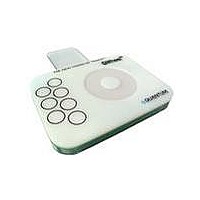E1106 Atmel, E1106 Datasheet - Page 10

E1106
Manufacturer Part Number
E1106
Description
BOARD EVALUATION FOR QT1106-ISG
Manufacturer
Atmel
Specifications of E1106
Sensor Type
*
Sensing Range
*
Interface
*
Sensitivity
*
Voltage - Supply
*
Embedded
*
Utilized Ic / Part
*
Interface Type
USB
Lead Free Status / RoHS Status
Lead free / RoHS Compliant
For Use With/related Products
QT1106
Other names
E1106AT
CalW - Recalibrates the wheel/slider.
Set CalK/CalW only once when required, and set CalK/CalW
= 0 thereafter. If the bit is constantly set to 1, the device will
keep recalibrating and will become non-responsive.
Note that the device recalibrates automatically on power-up,
so that the use of Recal should rarely be required excepting
Key 7 when used as a proximity sensor, in which case this
channel should be recalibrated soon after each proximity
detection to ensure stability.
Resolution - the resolution of the wheel/slider’s reported
Note: a resolution change will only become effective on the
next touch.
3.5.3 Custom Threshold Command Mode
The custom threshold command mode is used to modify the
detection threshold of the wheel/slider. It only needs to be
sent once, for the new value to take effect, and then the
normal command mode resumes (see Section 3.5.2, page 9).
The new value will be in use until the chip is reset or a new
custom threshold is sent.
Lq
CalW = 0: No recalibration (normal state of this bit).
CalW = 1: The device recalibrates the wheel/slider.
position. Refer to Figure 3.2.
Resolution
7
0
0
0
0
1
1
1
1
Bits
2 bits
3 bits
4 bits
6
0
0
1
1
0
0
1
1
SNSA
SNSA
SNSA
5
0
1
0
1
0
1
0
1
A3
A3
A3
Note: the first and last slider positions
(shaded) have larger touch areas.
0
0
Resolution
Reserved
2 Bits : 4 positions (0...3)
3 Bits : 8 positions (0...7)
4 Bits : 16 positions (0...15)
5 Bits : 32 positions (0...31)
6 Bits : 64 positions (0...63)
7 Bits : 128 positions (0...127) (default)
8 Bits : 256 positions (0...255)
0
1
2
1
3
SNSA
SNSA
SNSA
4
2
A1
A1
A1
Slider Mode
5 6 7
1
3
8
4
9 10 11 12 13 14 15
Figure 3.2 Wheel and Slider Resolution
SNSA
SNSA
SNSA
2
A2
A2
A2
5
6
(see end of Section 3.5.2)
3
7
SNSA
SNSA
SNSA
A3
A3
A3
10
When CT = 1, the three host command bytes should contain
the following bits:
T1: Custom threshold value of the wheel/slider. Higher
numbers are less sensitive. Touch detection uses this
threshold combined with a hysteresis equal to 12.5 percent of
the threshold (with a minimum hysteresis value of one).
Power-up default setting: 40
Note: Custom Threshold Command is only used if the
detection threshold of the wheel/slider needs to be changed
from the power-up default.
3.6 SPI Responses
The 3 return bytes which contain key states are as follows:
CTL: Custom Threshold Loaded: If CTL = 1, a custom
QM: QMagic Proximity Mode: If QM = 1, QMagic Proximity
LPS: LP / Sleep State: If LPS = 1, the device was in LP,
Byte #
SNSA
Host
wheel/slider threshold has been loaded from the host. If a
custom threshold is utilised, CTL can be used to indicate
if the threshold needs to be resent due to a reset of the
device.
mode is activated (see Section 2.6).
Sync, or Sleep mode when the requesting command was
received. If LPS = 0, the device was in Free Run mode.
A2
Return
byte #
1
2
3
1
2
3
6
5
CT=1
SNSA
7
4
3 bits
A3
7
0
CW
0
W
3
7
2
1
SNSA
A2
6
0
0
SNSA
CK
K7
A1
6
Wheel Mode
T1 - Wheel/Slider Threshold
3
2
5
0
0
SNSA
2 bits
EW
K6
A3
5
0
1
4
0
0
Position
QT1106_8IR0.07_0907
EK
K5
SNSA
4
Bit
A2
Bit
SNSA
A1
3
0
0
12
11
LPS
13
10
K4
3
14 15
9
SNSA
4 bits
8
A3
0 1
7
2
0
0
QM
K3
2
6
5
2
4
3
K2
SNSA
1
0
1
0
0
A1
CTL
K1
0
0
0
0













